Introduction:
Canola is an annual plant grown for its seed that originated from plants known as rapeseed. It is part of the Brassica plant family which includes mustard, cabbage, broccoli and cauliflower. The seed is crushed to produce oil, with the remaining meal used as livestock feed. Most rapeseed oil is unsuitable for human consumption and is used as industrial oils. However, Canadian plant breeders, using conventional breeding techniques, developed canola, which produces oil suitable for human consumption. The name “canola” was coined by the Rapeseed Association of Canada and is derived from the words “Canada” and “ola,” with ola referring to oil or oil low acid, depending on the source. The term was coined to avoid a negative association with the word “rape” or the more descriptive name “rapeseed oil.” Human consumption of rapeseed oil was banned by the U.S. Food and Drug Administration in 1956 due to naturally occurring, harmful chemicals, including euric acid and glucosinolates. Canola is a variety of the rapeseed plants (Brassica napus, B. rapa or B. juncea) that was bred to produce oil from the seeds that was low in euric acid (<2%) and glucosinolates (< 30 micromoles), both of which are harmful to human nutrition. Canola oil is used primarily as edible oil but is also used in the production of biofuels, industrial lubricants and additives to numerous other manufactured products. The meal remaining after the seeds are crushed to remove the oil is used as a high-quality livestock feed. The plant can also be used as forage for livestock.
Canola varieties include both spring and winter varieties. Spring types are planted in early spring, while winter varieties are planted in late summer to early fall. The winter-type canola varieties normally will have a significant yield advantage over spring types and are the varieties most commonly grown in most of the United States.
Canola production in the United States is centered in North Dakota. It leads the nation in seed production and produces about 80 percent of all seed grown. However, significant acreage is also planted each year in Oklahoma, Montana, Idaho, Washington, Minnesota and Oregon. Canola is increasingly grown in several other states, but has never been grown commercially in Nevada, and little information regarding survivability or yields has been developed. With increasing demands for crops that utilize less water than perennial forages, and high-quality food oils and federal regulations requiring increased use of biofuels, information on canola production in Nevada was needed.
In 2012, researchers from the University of Nevada, Reno, with support from a private company interested in testing canola production in Nevada, established a multilocation canola variety trial. The trial included five spring and five winter canola varieties.
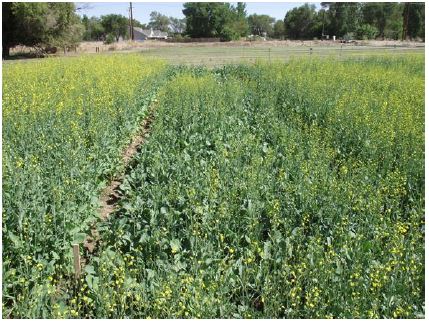
Experimental methods:
The variety trials were located at the University Newlands Research Field Station located in Fallon, Nev. and at its Main Station Farm in Reno, Nev. A third site located in Lovelock, Nev. was also selected, but the spring seeding failed due to poor soil conditions and problems delivering irrigation water in a timely manner. The Lovelock site was abandoned, and no data was obtained from that site.
Before seeding, the soils in each location were sampled and analyzed by a private soil laboratory. The Natural Resources Conservation Service (NRCS) Soil Survey lists the soils on the Newlands site as Sagouspe loamy sand, with 0-1% slopes. It is considered prime farmland if irrigated. The available water capacity is rated as moderate (approximately 7.3 inches). The normal frost-free period ranges from 120 to 140 days, and there were no potential limiting factors noted in the soil sample results. The Reno site is situated on the Truckee River with silt-loam soil and 0-2% slopes, according to the soil survey for Washoe County. It is rated as prime farmland if irrigated and drained. The available water-holding capacity is high (approximately 10.5 inches). The normal frost-free period is 100 to 110 days. Potential limiting factors noted on the soil test results were very high boron concentrations (3.0 ppm).
The canola variety trials were all planted in a complete randomized block design, with three replications per variety. The individual plot size was 9 feet by 50 feet. A 6-foot border of canola was planted around the perimeter of each plot to reduce any possible border effect.
The spring- and winter-type canola varieties were planted using a cone seeder at 6 pounds per acre (spring) or 5 pounds per acre (winter) gross seed weight. The Fallon site was planted on June 3 and Sept. 17, 2012. The Reno site was planted on June 4 and Sept. 18, 2012. The seed was planted approximately .25 inches deep and firmed with press wheels during the seeding operation. All sites were tilled, smoothed and firmed prior to seeding. They were weed free at time of planting as seen in Figure 1.
The spring planting dates for both sites were much later than those normally recommended for planting spring-type canola varieties, as high temperatures occurring during the flowering phase limit seed production.
Figure 1. Canola seeding operation in Fallon, Nev., 2012.
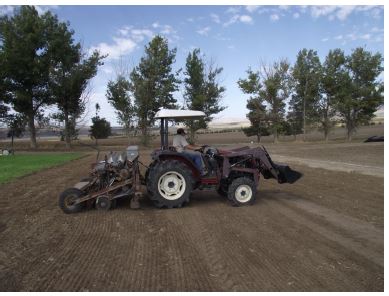
All sites were fertilized following the spring seeding and prior to plant emergence with ammonium sulfate (21-0-0) at the rate of 75 pounds actual nitrogen (N) per acre. The fertilizer was applied using a gandy-type drop spreader and irrigated following applications. The fall sites were fertilized after seeding with 21-0-0 at 50 pounds actual N per acre. They were irrigated immediately following the fertilizer applications. All sites were irrigated weekly using sprinklers, so that water was not a limiting factor to production.
Pest control on the spring-planted trials consisted of herbicide applications and regular hand weeding. All plots were treated with a tank mix of Volta Extra 2 (Thifensulfuronmethyl, Tribenuron-methyl) at .30 ounces per acre, and Select 2ec (Clethodim) at 4.5 ounces per acre. The materials were applied in 22 gallons per acre water treated with MOR-ACT® crop oil concentrate at 1% by volume. The primary weed species present was puncturevine Trinulus terrestris, Russian thistle Salsola iberica, Kochia Kochia scoparia, and various annual grass seedlings. The canola plants were in the one-four leaf stage when sprayed, while the target weed species were all in the seedling stages. No herbicide damage to the canola plants was noted. The treatments were applied approximately three weeks after seeding. No significant insect or disease pest was detected during the course of the study. However, some leaf beetle damage was noted. The Reno site experienced severe rodent damage to the seeded plants and was fenced to exclude rabbits and ground squirrels on July 6, 2012. The fall-seeded sites were not treated with any chemicals and were hand weeded as necessary. The fall-seeded Reno site experienced severe grazing damage from rodents, rabbits and geese during the winter and early spring. The seeding ultimately failed and was abandoned before any yield data could be collected.
The canola varieties evaluated were supplied by the cooperating company and were identified by a number only (spring) or named and numbered (winter). The winter types included commercially available varieties. The varieties evaluated are listed in Table 1.
Table 1. Selected spring canola varieties planted during 2012 at two locations in Nevada
Harvests of the spring-planted Fallon plots began on Sept. 26, utilizing a Kincaid plot combine. Treatments one, three and four were direct combined on this date, while treatments two and five were harvested on Oct. 2, 2012. The difference in harvest times was related to plant maturity. Treatments two and five were too green to harvest in September. All Reno treatments were harvested on Oct. 30, 2012, as they were too green to be harvested prior to that date. The Reno site was sprayed with glyphosate at approximately 0.5 % by volume on Oct. 1, 2012 to hasten plant dry down in preparation for harvest.
It is unproven but suspected that the early, heavy use by rodents delayed plant growth and seed production as compared to those growing in Fallon, which were undamaged.
The seed weights from each plot were recorded, and the seeds were cleaned by hand using appropriate sized screens and air flow to remove chaff and debris. The resulting weights were analyzed using IBM’s SPSS Analysis of Variance (ANOVA), and T-test statistical package, Version 20. Mean separation was accomplished using Tukey’s HSD at the P=< 0.05 level. The data were analyzed for difference in production (pounds per acre) among varieties at each site and between paired varieties growing on each site.
The fall-seeded Fallon site was harvested on June 1 and 2, 2013. All plots were hand harvested and threshed on site. The seed was cleaned by hand using appropriate sized screens and directed air flow to remove chaff and debris. All plots had dried adequately to allow harvest by this time. A spring type (Cibus 412) was included in the winter trial to evaluate if spring types could survive the winter in the Fallon area.
Results: Spring canola types
Seed production was generally higher from plants growing in Fallon as compared to those growing in Reno. There were significant production differences noted between the plants growing on the Fallon site. The highest yielding varieties in Fallon were 5720-3 and 5720-1, which produced 424.7 and 325.1 pounds per acre, respectively. Variety C412 was the third-highest producing variety with 304.1 pounds per acre. The varieties 5715 and C412 LB produced the least amount of seed at 144.2 and 73.4 pounds per respective acre. Figure 2 graphically displays significant yield differences for the canola varieties growing in Fallon during 2012.
Figure 2. Yields of five spring canola varieties grown in Fallon, Nev. during 2012.
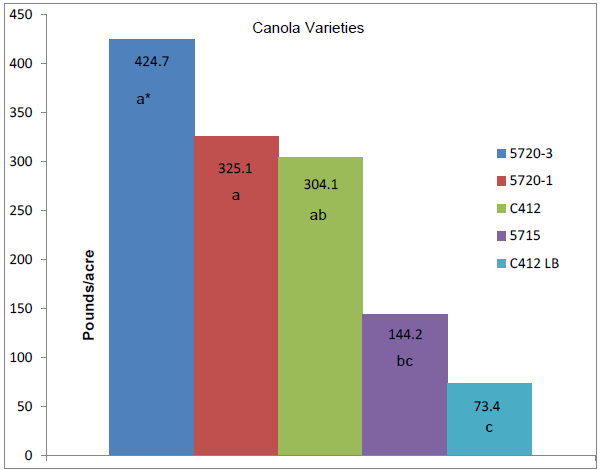
*Columns with the same letter are not significantly different at P=< 0.05.
Data From Figure 2
Reno canola yields were generally lower than those produced in Fallon. However, the three top producing varieties in Fallon were the same varieties as the top three producers in Reno. The largest producing varieties in Reno included C412, 5720-1 and 5720-3, which produced 312.0, 289.8 and 276.1 pounds per acre, respectively. Variety 5715 produced 103.1 pounds per acre, while variety C412 large bag, produced only 46.5 pounds on a per acre basis. Figure 3 graphically displays significant yield differences for the canola varieties growing in Reno during 2012.
When production of all the canola varieties is compared across both production sites, production slightly favored the Fallon site. However, there were no significant differences noted between the top three varieties. Table 2 displays a comparison of the production results for all varieties produced in Fallon and Reno in 2012.
Figure 3. Yields of five spring canola varieties grown in Reno, Nev. during 2012.
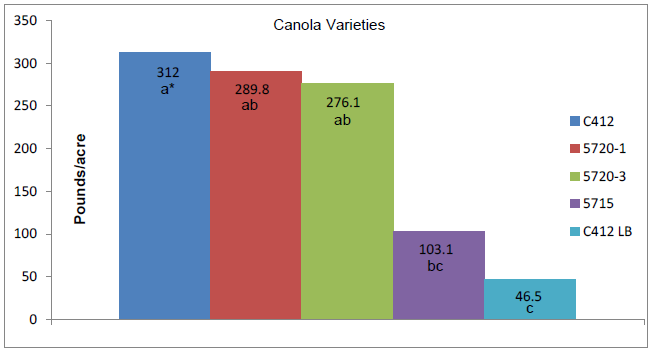
*Columns with the same letter are not significantly different at P< 0.05.
Data From Figure 3
The final analysis completed on the spring canola varieties compared production values of each variety paired by location, and no significant differences in production related to the location where the variety was grown were detected at the 5% probability level according to Tukey’s HSD. For example, when the production values of variety C412 grown in Fallon was compared to the values of C412 grown in Reno, there was no significant difference due to the location.
Table 2. Yields of five canola varieties grown in Fallon and Reno in 2012.
*Entries followed by the same letter are not significantly different at P=< 0.05.
Winter canola types
While the winter canola varieties were planted in Reno and Fallon, only the Fallon site produced measureable results. When compared to the spring types, all of the winter canola varieties produced much heavier yields, regardless of the variety or the location of where the spring types were planted. The spring type (Cibus 412) emerged in the fall but winter killed the seedlings, and the seeding failed.
Wichita and Riley, the two highest yielding winter varieties, produced over a ton of seed per acre in this trial. Sumner produced over 1700 pounds per acre and BN11 produced nearly 1000 pounds per acre. The lowest yielding variety, Cibus 411 produced a little over 450 pounds/acre, which was still more than any of the spring types planted the previous year produced. Figure 4 displays the seed production results of the winter canola trial in Fallon, Nev.
Figure 4. Yields of five winter canola varieties grown in Fallon, Nev. during 2013.
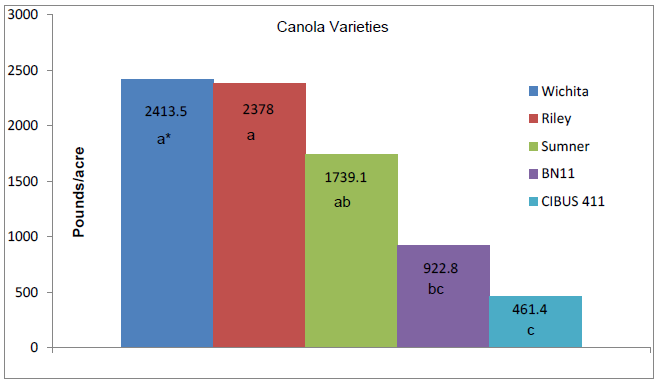
* Values with the same letter are not significantly different at the P=< 0.05 level.
Data From Figure 4
Discussion: Spring canola varieties
The purpose of this project was to evaluate the growth and production potential of five proprietary, spring canola varieties at two locations in western Nevada. Due to several factors, the planting dates for the spring varieties were delayed well beyond that normally recommended when planting spring canola varieties. Spring canola yields are inversely related to planting date. A long-term study by Washington State University found that spring canola yields were reduced by over 40 pounds per day for canola planted after mid-April. The reduction in yields is related to heat stress during the flowering period. Based on this figure, the varieties evaluated in this trial would have lost over 2,000 pounds per acre in potential production.
All of the spring canola varieties evaluated in this trial were flowering during the hottest portion of the summer months, undoubtedly reducing potential yields. Flowering began around the first of July and continued through late August. Temperature data from Fallon during the time period from July 1 through August 30, 2012 revealed that the maximum air temperature was in excess of 90 F daily, except for seven days when it was in the upper 80s. During the hottest portion of the days during this time period, the canola plants wilted, regardless of the irrigation schedule.
While production was very low on average, plant vigor and health appeared to be excellent for all varieties evaluated on both locations. All varieties developed full stands, large leaves and long flowering stems. The lack of serious damage from insect or disease pests may also indicate plants growing in a vigorous state.
In spite of the late planting date, spring canola production in western Nevada looks promising. This observation is based on the overall plant health, vigor and production experienced during this trial. Further evaluation with these and other varieties is warranted if proper planting dates can be achieved. Planting dates should correspond to or be earlier than those recommended for spring grain production in western Nevada. Typically, spring grains are planted no later than early April, and as with canola, yields decline precipitously with later planting dates.
Winter canola varieties
The purpose of the project was to evaluate the growth and production potential of several commercial and proprietary winter canola varieties planted at Fallon and Reno, Nev. A spring-type (C412) variety was also planted to determine the potential winter survival of a spring-type canola. Winter killed the spring variety at both locations, and no data was gathered from this variety.
The planting dates of mid-September corresponded to the recommended dates for winter-type canola, and all varieties in both locations emerged and grew successfully until cold temperatures resulted in winter dormancy. The plants growing in the Reno location were subject to severe grazing pressure from Canada geese, ground squirrels and rock marmots during the winter and early spring. The grazing prevented the young plants from developing normally, and the seeding was abandoned.
The plants growing on the Fallon site grew rapidly and flowered profusely, resulting in excellent seed pod development. No serious insect or disease damage to the plants was noted during the trial.
According to the United States National Agricultural Statistics Service’s 2014 crop production report, average canola yields for the United States were 1622 pounds per acre. While most of the canola grown in the United States is grown without irrigation, significant acreage is irrigated, especially in the more southern states. Irrigated yields are normally higher than nonirrigated yields. The National Winter Canola Trial does separate irrigated trials from nonirrigated trials, and the threeyear irrigated average yields for the three tested varieties are shown in Table 3. The table also includes the yields obtained from the same varieties grown in Nevada under irrigation.
Table 3. Three-year yield averages (pounds/acre) from 39 site/years (National Winter Canola Trials) and one site/year (Nevada) for selected varieties of winter canola in the National Winter Canola Variety Trial on the Great Plains and the Nevada Trial.
*Pounds/acre
The Nevada yields are slightly less than the average yields obtained under irrigated conditions in several other states. However, the high yields and lack of significant insect, disease or climatic damage indicate that winter canola shows promise as an alternative crop in Nevada if economic factors are favorable for production.
Canola seed prices paid to the farmer have varied greatly over the last five years, according to the Economic Research Service of the United States Department of Agriculture. The price per ton has ranged from a low of $225 to a high of $330. Even at the highest level, canola seed prices cannot compete with that paid to farmers for teff, another annual seed with similar production practices, costs and yields. Teff seed prices paid to the farmer have averaged approximately $900 per ton over the same time period (5). Therefore, unless canola seed prices increase dramatically, commercial production is unlikely in Nevada.
References cited
- 1) "The History of Canola." The Canola Council of Canada. The Canola Council of Canada, The History of Canola Accessed, April 9, 2015.
- 2) United States Department of Agriculture, National Agricultural Statistics Service. 2015. Crop Production, 2014 Summary. Crop Production Accessed, April 9, 2015.
- 3) United States Department of Agriculture, Economic Research Service. 2012. Soybean & Oil Crops, Canola. Canola Accessed, April 9, 2015.
- 4) United States Department of Agriculture, Economic Research Service. 2015. Oil Crops Yearbook. Oil Crops Yearbook Accessed, April 9, 2015.
- 5) Eckert, D. Desert Oasis Teff LLc. 2014. Personal communication on December 22, 2014.
Davison, J.
2015,
Spring and Winter Canola Variety Trial Results in Nevada,
Extension | University of Nevada, Reno, FS-15-07


